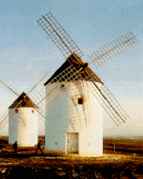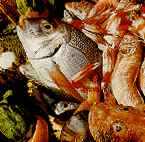Special Feature: Products Sally Recommends
Ethnic Cuisine: Spain
introduction | glossary | cookbooks | recipes | travel | crossword
Located in southwestern Europe, Spain is the third largest European country. It controls the crossroads between two seas -- the Mediterranean and the Atlantic. It is exceptionally mountainous and climatically it is much drier than the rest of Europe. The landscape ranges from arid mountain pasture to lush orchards and meadows, from magnificent coasts to rural or sophisticated towns.
Spain's location and the mineral wealth of its sub-soil have exercised an attraction for many people, especially foreign political and ethnic interests. Thus, its ethnic and cultural heritage is complex. It is an area of Europe much fought over and invaded.
It's history began with Phoenician, Greek, and Carthaginian coastal settlements. Later the Romans, and more importantly the Moors, brought with them elements of their own cooking which lingered and blended with Spain's culinary heritage. Imports from the New World included the tomato, potato, sweet potato, vanilla, chocolate, many varieties of beans, zucchini, and the pepper tribe. There are olives in profusion, vineyards and citrus fruit. Spaniards are very fond of garlic, they love all types of sweet and hot peppers and their beloved jamon serrano -- cured ham. The golden spice saffron enhances many Spanish foods, paella in particular. Spain's most famous wine -- sherry, both dry and sweet -- flavors entrees and desserts.
 Cuisine
in the Iberian peninsula echoes the cooking of the Middle East (honey and cumin)
and that of the Americas (dishes combining meat with chocolate). Yet, essentially,
it is family cooking, comparatively simple to prepare and characterized by fresh
ingredients. Besides meat, poultry, game, and fish entrees, there are a wealth
of dishes featuring beans, rice, eggs, vegetables, and savory pies that make a
meal. Tapas -- small morsels or appetizers in great variety -- play a role in
meals throughout the day.
Cuisine
in the Iberian peninsula echoes the cooking of the Middle East (honey and cumin)
and that of the Americas (dishes combining meat with chocolate). Yet, essentially,
it is family cooking, comparatively simple to prepare and characterized by fresh
ingredients. Besides meat, poultry, game, and fish entrees, there are a wealth
of dishes featuring beans, rice, eggs, vegetables, and savory pies that make a
meal. Tapas -- small morsels or appetizers in great variety -- play a role in
meals throughout the day.
Spanish life-style is vastly different from Americans'. A typical dining pattern involves a light breakfast at 8 a.m.; a mid-morning breakfast at 11 a.m.; tapas at 1 p.m. with a three-course lunch following at 2 to 3 p.m.; a merienda for tea and pastries or a snack at 5 to 6 p.m.; evening tapas at 8 p.m. or later, and a three-course supper at 10 p.m. The two main meals of the day -- la comida, or lunch, and la cena, dinner -- are no less opulent because of in-between snacks.
While eating habits and hours are more or less uniform throughout Spain, the cooking can be quite different. Spain is sharply divided by regions, each with its own culinary traditions and dialects.
 The northwestern area, Galicia,
prominently displays its ancient Celtic heritage. Meat and fish pies are found
here along with famed scallops and fine veal. Farther east along the coast, Asturias
is known for its legendary bean dish, fabada, and a strong blue cheese, queso
Cabrales. Hard cider is preferred as a drink.
The northwestern area, Galicia,
prominently displays its ancient Celtic heritage. Meat and fish pies are found
here along with famed scallops and fine veal. Farther east along the coast, Asturias
is known for its legendary bean dish, fabada, and a strong blue cheese, queso
Cabrales. Hard cider is preferred as a drink.
The Basque country features fish dishes principally, such as fish soup, garlicky baby eels, squid, and a variety of dried cod dishes.
Cataluna is considered the most gastronomically distinctive and exciting region of Spain. Catalan cuisine is inventive with fish, such as mixed seafood zarzuela, meats or poultry, which are typically combined with local fruits. Valencia is a region of tidal flatlands and rice is prepared here in endless styles on a daily basis. Paella is the region's most famous dish. Andalucia to the south is a parched and arid region, best suited to grape vines and olive trees. Gazpacho is native to this area.
more on Spanish Cuisine...
introduction |
glossary |
cookbooks |
recipes |
travel |
crossword
Note: This information was accurate when it was published. Please be sure to confirm all rates and details directly with the businesses in question before making your plans.



